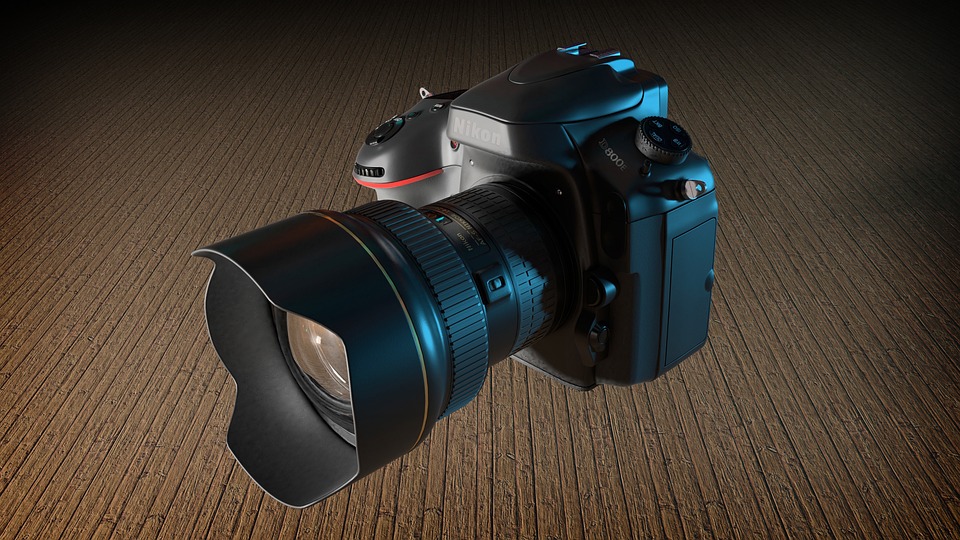The Nikon D5300 camera is among the top mid-range DSLR cameras available currently, but the quality of a single image is as good as the lens it was shot using – ensure you’ve got the top lens for the Nikon D5300.
Landscape photography is among the most well-known photography genres However, just like any other genre the ability to capture stunning photographs of landscapes is, at the very least, dependent partially, on having the appropriate equipment. This includes your camera lens and Nikon is among the most popular camera brands on the market. Perhaps you are thinking about which is the most effective camera lens to use with Nikon cameras and why it’s crucial for landscape photography.
Here we will present the top 5 lenses for Nikon D5300 landscape photography but before that, we’ll talk about the reasons you need a particular camera lens and what makes a great landscape lens.
What is the Reason You Require an Extra Lens for Your Landscape Camera?
It is possible that you do not only require one lens on your camera for landscape photography. You may require multiple. The reason for this is that there is a broad range of photographs that you can make. It is possible to take photos with all kinds of illumination conditions, beginning with stunning colors of the sunset to the mysterious landscape of a forest encased by fog. It is also possible to zoom on your subject using a wide-angle lens in order to achieve that panoramic view. If the budget you’ve set for the lenses of a camera is limited, you’ll have to look at your options to cover possible landscape photography options that you could be confronted with.
Essential Features of Landscape Photography Lenses
- Low Light Performance: If you’re taking photos of landscapes, there will be instances when the lighting conditions aren’t ideal which is why you’ll require a camera lens that has a bigger aperture. An aperture at f/1.8 or lower can help to create clear, sharp images even when there isn’t a lot of lighting. If the maximum aperture you can get is f/5 or smaller isn’t working, it’s not a good choice under low lighting conditions.
- Focal Length: The focal length is the camera lens’s level of zoom. A lens that has a fixed focal length can help create better quality photos since there is no chance for any error in the movement of the glass. However, it’s usually more beneficial to choose a flexible focal length as you don’t want to purchase a new lens for each angle you could encounter. When it comes to landscape photography, it’s usually recommended to choose an aperture between 10 to 45 millimeters.
- Lens Distortion: The term is used to describe pictures where straight lines appear bent. Wide-angle lenses can be troublesome with distortion, however, the majority of known brands will offer superior results. Telephoto zoom lenses can cause higher distortion than primary lenses, however, when using wide-angle lenses, there’s an inherent distortion that’s hard to eliminate. It’s generally easy to correct distortion with software for editing photos such as Photoshop or Lightroom however If you’re planning to shoot many geometric patterns or buildings it is recommended to select one of the wide-angle lenses that has the least distortion for your camera. If that’s the situation you’ll need a prime lens. lenses could be better suited for you.
Tips to Keep in Mind Before Purchasing a lens for Nikon d5300
There are some crucial things to think about prior to deciding on the perfect Nikon landscape lens:
- Range of aperture: The range of the aperture is one of the primary concerns for landscape photographers. The aperture is the quantity of light that goes through the expandable, contactable, and expandable aperture that the lens has. The aperture number is a reference to an f stop, and the greater the number is the narrower the aperture. The lower numbers, the bigger the opening. Thus an aperture of f/8 will let in more light than an aperture of f/11. This is the aperture you need to shoot landscapes. An aperture between f/8 to f/11 can usually help you to maintain the whole image in focus.
- The weight of the Lens It is an important aspect to consider for landscape photographers who carry not just the lens as well as the camera and other gear for hiking in the harsh landscape. Lenses come in different sizes and weights, and the majority of landscape photographers prefer to utilize zoom lenses that can be more flexible than prime lenses with similar focal lengths. Therefore, consider what you’ll use the lens, as well as the best way to store it prior to selecting a model.
- Focus The final point is that most photographers who shoot landscapes also capture objects that move quickly, like birds or other creatures. That’s why they require a fast focus mode, but if this is not your style then you may prefer an autofocus lens or at the very least, one that offers the possibility to focus manually.
- Vibration Reduction Technology that reduces vibration lets the lens focus quickly and quietly. It’s not something you think about when thinking about it but, when you require the feature, you’ll grateful that you have the technology for reducing vibration.
- Wide-angle The discussion has been on the advantages of wide-angle lenses for photographs of landscapes But what exactly is the meaning behind that phrase? Wide-angle lenses go beyond simply allowing you to be farther, but they also enhance the feeling of distance and space within the landscape. They also can help bring the illusion of depth and an extra dimension to the photo.
For shooting landscapes, Wide-angle lenses generally mean anything larger than 35mm in a full-frame camera, and 25mm on an A-C or crop sensor camera. If you are too low at the other end it is possible to achieve a fisheye look. Sometimes, you’d like that but when you’re not careful you’ll get some significant distortion in the edges of the picture. For truly wide-angle landscape photography generally, you’ll need a lens for your camera that is between 14 to 24 millimeters.
The kind that Nikon camera you select determines the lens that you choose for the camera and the pictures it can produce. Nikon sensors that are cropped provide a more zoomed-in look, whereas cameras that have full-frame sensors allow for a wider view. You’ll need the Nikon lens that is compatible with the size of your camera’s sensor and, of course, the lens is designed to fit the camera’s model. So, what are the top lenses for Nikon 5300 landscape photography in terms of landscape photos? We’ve got a few ideas.
5 Best Lens For Nikon D5300 Landscape Photography
Here are our top nine choices for the top five best lens for Nikon D5300 landscape Photography.
1. Nikon AF-S DX 8-15mm
Main features:
- F-Mount Lens/FX Format
- Aperture Range: f/3.5 to f/29
- Three Extra Low-Dispersion Elements
- Two Aspherical Elements
- Nano Crystal & Super Integrated Coatings
- Protective Fluorine Coating
- Silent Wave Motor AF System
- 180deg Angle of View
- Electromagnetic Diaphragm Mechanism
- Rounded 7-Blade Diaphragm
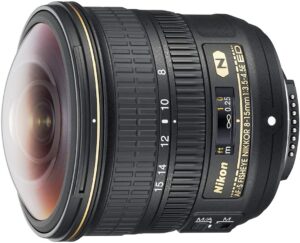
This Nikon lens won’t be one you will use every time however it does provide the user a unique view. The AF-S 8-15 millimeter lens has two wide-angle options, the 8mm circular, or the 15-millimeter fisheye. With the 8mm circular lens, you have a 180-degree view angle and can result in stunning circular landscapes.
The other option for this lens would be the 15mm lens, which produces breathtaking fisheye landscapes. They look like panoramic photos. With an aperture range between f/3.5 up to f/4.5 and silent autofocus and stunning image quality, it is simply outstanding even on the edges. Additionally, the lens is weather-proofed to stand up to the harshest weather conditions. It’s an ideal option for the professional photographer of the landscape.
2. Nikon AF-S NIKKOR 24-120mm
Main Features:
- F-Mount Lens/FX Format
- Aperture Range: f/4 to f/22
- Three Aspherical and Two ED Elements
- Nano Crystal & Super Integrated Coatings
- Silent Wave Motor AF System
- VR II Image Stabilization
- Rounded 9-Blade Diaphragm
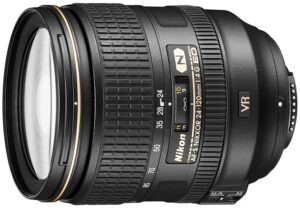
This Nikon Telephoto lens features an aperture of f/4, the maximum, and has a nano crystal coating to prevent flaring of the lens and ghosting. It’s one of the highest-rated Nikon zooms for landscapes that telephotos and are a great alternative to the 24-70 millimeter zoom lens. This Nikon lens offers a bit of additional flexibility, and the picture quality of the telephoto lens is excellent. It’s a great choice for a variety of photography requirements.
Because of the zoom range, it is possible to capture a variety of landscape shots. The autofocus and precision are outstanding, and its hand-held focus rings are simple to utilize. In addition, the vibration reduction technology for image stabilization allows it to focus fast and quietly. The Nikon Telephoto lens can cause some distortion however it’s something that can be fixed during post-production.
3. Nikon Z 14-30mm f/4 S
Main Features:
- Z-Mount Lens/FX Format
- Constant f/4 Maximum Aperture
- Four ED and Four Aspherical Elements
- Nano Crystal & Super Integrated Coatings
- Stepping Motor AF System
- Programmable Control Ring
- Weather-Sealed Design, Fluorine Coating
- Rounded 7-Blade Diaphragm
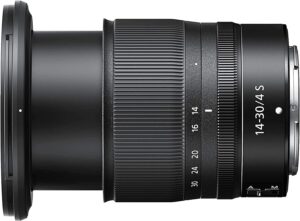
It is also the very first 14mm Ultra-wide Zoom Nikon landscape lens that is extremely mobile and can be used with 82mm filters.
4. Nikon AF-S NIKKOR 16-35mm
Main Features:
- F-Mount Lens/FX Format
- Aperture Range: f/4 to f/22
- Three Aspherical and Two ED Elements
- Nano Crystal Coat
- Silent Wave Motor AF System
- VR II Image Stabilization
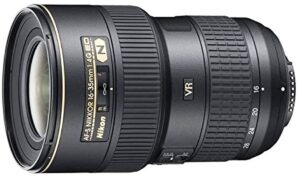
It’s one of the top Nikon Landscape lenses. It’s compact, affordable, and can produce sharp images. Because of the vibration reduction stabilization feature, you may be able to skip the tripod occasionally. This can be useful when you’re out hiking or traveling with all the camera gear.
5. Nikon AF-S FX NIKKOR 20mm
Main Features:
F-Mount Lens/FX Format
Aperture Range: f/1.8 to f/16
Two Aspherical Elements, Two ED Elements
Nano Crystal & Super Integrated Coatings
Silent Wave Motor AF System
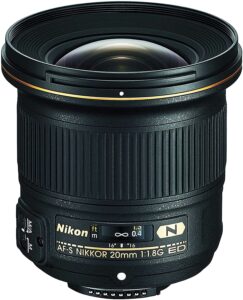
This ultra-wide-angle, affordable Nikon Landscape prime lens comes to light and is compact. It features an SWM for silent focusing, two ultra-low dispersion glass elements, and the nanocrystal coating which reduces reflection. It also has a narrow focus distance of 0.2 meters. Its max aperture of f/1.8G allows for greater separation of your focus and background.
Frequently ASK Question(FAQ)
Q. What lens should you use for landscape photography?
The most effective combination of lenses to capture landscapes is usually the combination of a broad-angle lens and a conventional zoom lens, and zoom lenses. They typically encompass focal lengths that range between 160mm and 200mm.
Q. Is Nikon D5300 good for wildlife?
Yes. Nikon’s D5300 camera is ideal for amateur wildlife photographers. The only thing that you won’t achieve is continuous mode photography. It’s likely that you’d prefer RAW with 14 bits. In this mode, the D5300 can capture the rate of 4 frames per second it is in constant mode.
Q. Is Nikon D5300 good for portraits?
Nikon D5300 has a grade of 56 for Portrait Photography. It is a typical candidate for this kind of photography.
Q. Is Nikon D5300 a DX or FX?
The reason is the Nikon D5300 has a smaller than full-frame sensor. This is what Nikon calls the “DX,” “DX,” sensor. “You should have gotten an FX (full-frame) camera,” she was advised by the photographer. “DX” and “FX” are Nikon’s terms with respect to the dimensions of cameras ‘ sensors.
